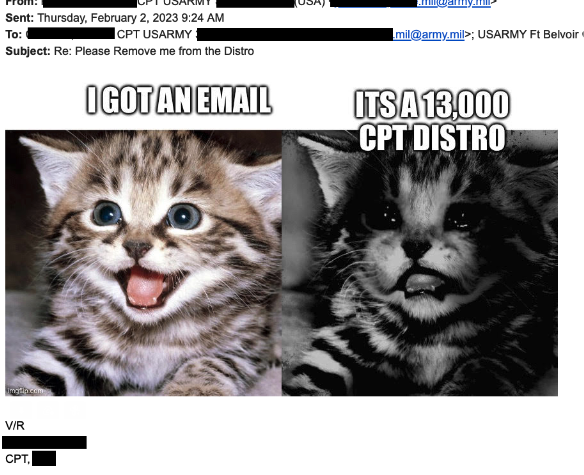Reply-All is an email feature that often provokes strong emotions. On the one hand, it lends itself to overuse, as we shall see below. On the other hand, in some contexts, like group projects, Reply-All is a necessity, and often – infuriatingly – people just won’t use it. Let us take a closer look at how to navigate the treacherous waters of Reply-All.
Reply-All disasters
In February 2023, the Modeling & Simulation Office at the US Army Fort Belvoir sent a message to its entire distribution list. This list was supposed to consist of interested, eligible officers potentially interested in entering the field. However, the message was sent to over 13,000 soldiers, most of whom never intended to have anything to do with modelling or simulation. Mayhem ensued when recipients of the message started asking to be removed from the distribution list, by clicking on the dread Reply-All button.
The situation gave rise to many creative and amusing responses, like the officer who begged in rhyme to be taken off the list:
I’ve tried to unsubscribe, I’ve hit the button with might,
But still the emails keep coming, day and night,
It’s like a never-ending stream, with no escape in sight,
I just want to be free from this digital plight.
There was also an abundance of memes:

R.I.P. to everyone who got to work with 100s of emails in their inbox.
The situation at Fort Belvoir is far from unique. Anyone who has to deal with colleagues in a corporate or academic setting via email will have experienced the Reply-All inbox avalanche. Sometimes an unintended Reply-All email can embarrassingly reveal the sender’s private thoughts or situation as in the company where an email went around saying expenses would no longer be reimbursed when processed but only on the 15th and last day of the month. One high-earning senior executive inadvertently revealed her financial troubles when she replied to all 14,000 employees saying this was unacceptable and how she only had less than 5 dollars left in her account to buy food until the end of the month and was relying on expenses to eat.
When you need to Reply-All
There is also a virtuous – and very much necessary – use of Reply-All. , which involves replying to all participants in the email chain in order to keep them in the loop. This is particularly important in group projects, where coordination and being on the same page are necessary to avoid misunderstandings and delays. However, because of the risk of mass email fiascos, many people will shy away from clicking the Reply-All button as intended – much to the frustration of project managers everywhere.
In an experiment on replying behavior in group email communications, researchers found that most people will err towards Reply even when asked to Reply-All because they are worried about starting a collective email chain reaction. When they do misuse Reply-All, it is usually because of a “lack of universally agreed upon criteria for appropriate Reply/Reply-All choice.”
The study bears closer examination. The authors found that “erroneous use of Reply features is prevalent among email users,” mainly because of the message directive (or lack thereof) and the email addresses displayed. People were less likely to Reply-All, even if directed to do so, when an email list was displayed, and took longer to respond to emails displaying multiple addresses. Participants said they were more likely to Reply-All if the email was not addressed to a large group, and if the sender originally included a set of addressees of colleagues for whom the email was clearly relevant.
However, the results also show that, in the case of emails addressed to more than two people, some participants believed all recipients should be included, whereas others focused on how relevant their response was to others. In the latter case, differing perceptions of “relevance” – judging that their response would not be important for everyone – led participants to avoid pressing the Reply-All button despite being expected to do so.
When a Reply-All response is required,it must be made clear to recipients that their response is relevant to everyone! How to do so, while avoiding the pitfalls of the Unwanted Reply-All? The study’s authors suggest improving email design features to help people make more accurate response choices. The other potential solution is establishing a “culture of explicit norms and expectations within a community or users in general.” Of course, both things are easier said than done.
What to do then?
One way to reduce recipients’ fear might be, as shown by the study, to avoid email lists in favor of explicitly displaying all the individual email addresses involved – in a project setting, people will be able to more clearly recognize their fellow team members. Another way could be including “PLEASE REPLY TO ALL” at the start of the message, e.g.
Hello, this is Jack from Accounts. Please hit Reply All when answering this email, as it’s super important that we are all kept in the loop.
The reminder can even be included in the subject line:
Subject: PROJECT AURORA DEADLINES – PLS REPLY ALL WHEN ANSWERING
Unfortunately, no measure is perfect, and most likely, there will always be someone who misses the memo. In which case, project managers, the only option is the good old passive-aggressive, fake-cheery, many-exclamations-marks-added-to-conceal-irritation reminder:
Thank you for these 48 databases, Linda. As we discussed, please share them with the entire team, so we are all on the same page? Thanks!!!!
